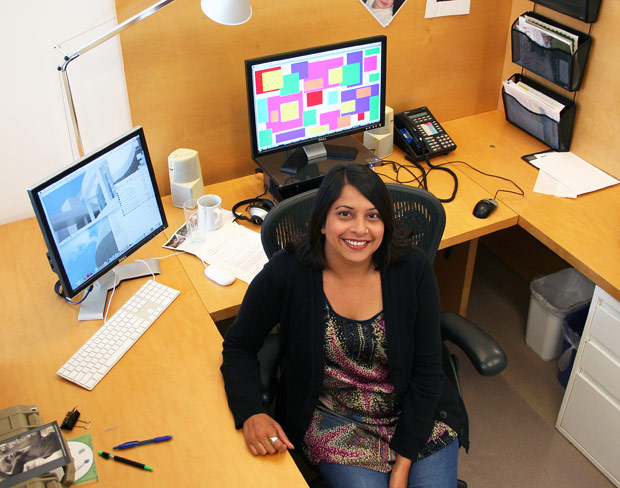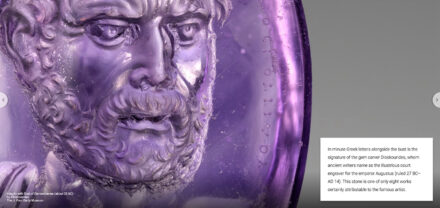
What do you do at the Getty?
I work on a variety of Web and new media projects that allow me to collaborate with my colleagues within the Web Group as well as other departments across the Getty.
I’m a Web content administrator, but I think that’s kind of a boring title for all the interesting work I get to do!
What projects are you working on?
We’re helping the Getty Research Institute create an online collaborative tool for scholars to analyze a manuscript. Researchers will be able to share their annotations of the manuscript, post their discoveries, and see what other people are discovering.
I’ve also been working on the code for our Web site’s new video player. People are now able to see our newest videos in high quality and fullscreen, share on other Web sites via embed code, and download related files like transcripts and iPod versions.
Do you have a favorite project?
Working on our multitouch table has been an exciting project! We did a trial run for the AAM annual meeting and created a really cool touchable, scalable map with points of information about cultural institutions in Los Angeles. We used Google’s Map API, Flash, and the GestureWorks library (which makes things touchable) to develop our application. We hope to develop more projects for the multitouch table, hopefully very soon!
I think the video player has been my favorite project, though. I’ve learned so much along the way.
Is it difficult to help non-technical people understand all the work that goes on behind the scenes?
(Laughs.) Sometimes—but I think that sort of understanding applies to every job. To me, it’s not that important for people to know how long I spent on something, as long as they appreciate the final product. I don’t expect people who don’t have technical experience to understand that it took two days to find a missing semicolon in a line of code!
What is your educational background?
I got my B.A. in interactive multimedia from Columbia College in Chicago, where I grew up. There I learned about Web development, design, and techniques for making content interactive.
Most of my experience, though, comes from my four-year master’s program in electronic visualization from the University of Illinois at Chicago. I worked in the Electronic Visualization Laboratory, which is known for cutting-edge technology such as virtual reality. It was like a playground with really cool high-tech toys for computer scientists and artists.
What personal qualities help you in this job?
Determination! When I face a problem, I won’t give up, because I just have to find the answer. I constantly turn things over in my head, trying to figure out how to approach the problem in a different way. You’ll always find the answer. Maybe not in time for your deadline, but it will come to you. (Laughs.)
How do you keep up with all of the new developments in your field?
I learn a lot from my colleagues. Word of mouth is definitely the best way to find out what’s going on out there.
One of the things I love about my job is that there are opportunities for research and development. There’s definitely a lot of work to do, but there’s also time to experiment and learn new things.
You do video art yourself, don’t you?
For my master’s thesis I created an interactive, 10-by-10-foot video installation about memories titled Cue. I’m really tied to India. I was born there, and we immigrated here when I was three. We try to visit about every five years to see our extended family. I started thinking about how memory is triggered, and I realized that for me, memories of India came up very often. For example, if I hear a motorcycle drive by, it might bring up a memory of riding in a rickshaw around my neighborhood in India.
Using open-source software, I wrote motion-detection code that also detected what color you were wearing in the installation space. If the camera captured you wearing a certain shade of red, for example, a clip of my cousin wearing a red sari on her wedding day would be cued to play from my database of video memories. The lab posted video documentation of what the Cue experience was like on YouTube.
Do you see a similar relationship between art and technology in your work at the Getty?
I do! It’s great to listen to what people want and to try to make those ideas come alive.
Now for the important question: How did you get the idea to do a flash mob at Getty Underground?
People had been forwarding YouTube videos of flash mobs all over the world, and I thought that looked like so much fun! The reactions of bystanders are the best part—it’s great to surprise people and make them laugh. I wanted to do Michael Jackson’s “Thriller” or Madonna’s “Vogue,” but I thought those dances would’ve been hard to learn with the time we had, so I decided on a mix of different line dances. I figured it would be easier and a great way to get other people to join in.
Thank you for not picking “Thriller,” I wouldn’t have been able to keep up with those steps!
I want to do it again! That was a great practice run. Maybe next time we could do something more challenging…like Lady Gaga!




The multitouch link needs a “iris” added :- )
You’re right! Thanks for flagging the coding error — it’s fixed now. –Annelisa